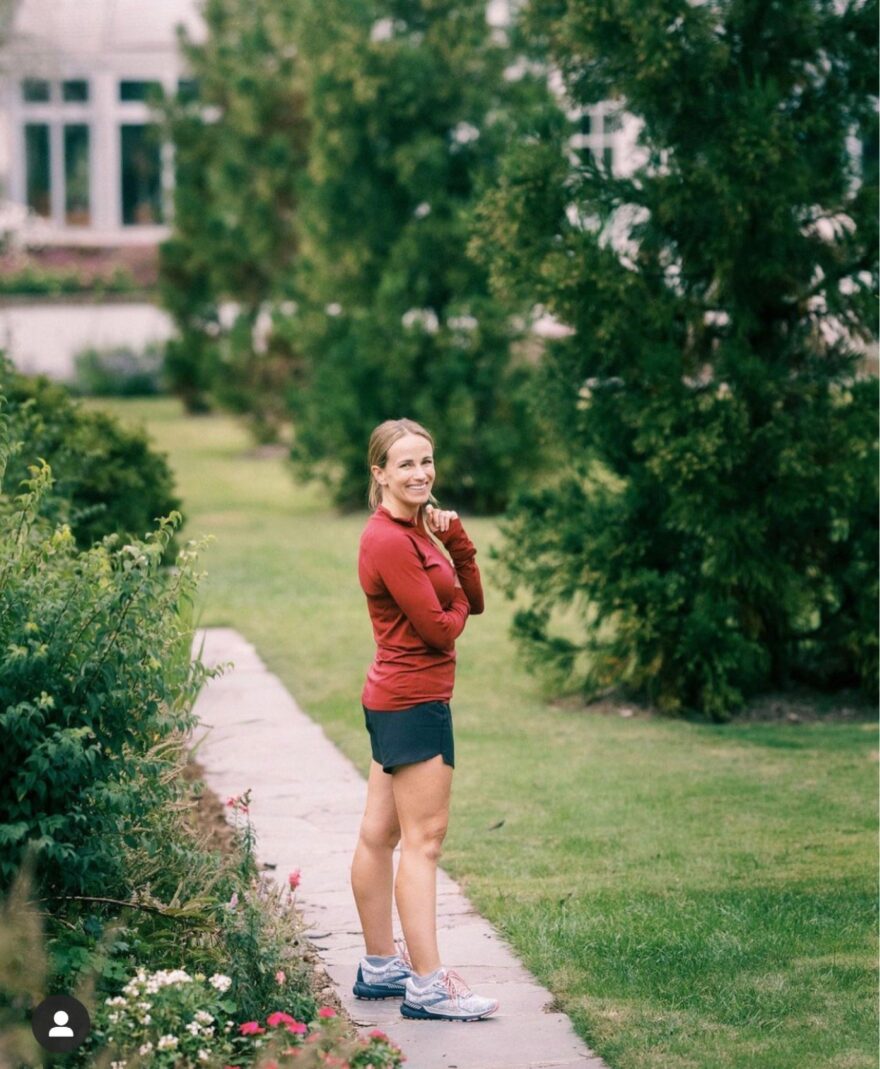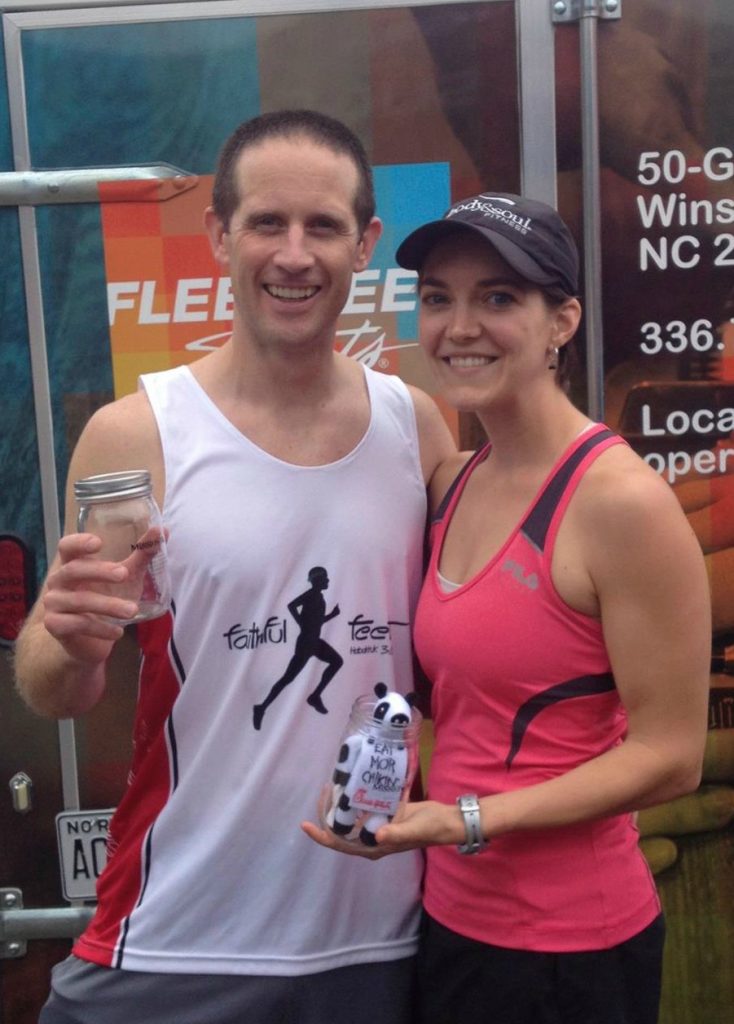


I’ve been running for over 17 years, and along the way, I’ve dealt with shin splints. Here what causes it, how to heal it and whether you can/should run through it!
I recently chatted with Dr. Christopher Miles from the Wake Forest Baptist Health Sports Medicine department about common running injuries, and today I’m sharing his expertise on how to treat shin splints.
Dr. Miles is an avid runner himself and also treats the athletes who play for Wake Forest University’s football and basketball teams. I’m so grateful to have him on the blog!

Alright, onto the Q&A with Dr. Miles! (My comments are bolded or italicized. All sarcasm and opinions in the italics are my own. :))
How do you diagnose shin splints, other than a patient complaining that it feels like the muscle is being ripped from their bone while a fire-breathing dragon pours salt on it?
The most common complaint is anterior leg pain (that’s the front of the leg if you don’t know where your shin is), either vague or very specific pain. I look for any pain from the ankle to the knee in someone who is very active. During an in-person exam, I look for tenderness when pressing on the area and also look for indication of a stress reaction or stress fracture based on the level of pain.
Okay, so you pressed my shin and that did not feel nice. I have shin splints. Why me?
Shin splints are more common in females, at any age (great), but I see them in both males and females. There’s speculation as to why it impacts females more but there’s no clear answer. Shin splints usually happen when someone increases their running too quickly (either mileage or intensity) or if there is a major footwear issue.
Tell me more about these footwear issues.
If you’ve never had your foot and gait analyzed, a specialty running store can usually help with this and put you in the right shoe. A sports medicine doctor can also help evaluate your gait and recommend the type of shoe you need. (I never would have thought to ask my sports medicine doctor about what type of shoes I need, but it makes perfect sense now he mentions is. If you’re local, I recommend Fleet Feet for gait analysis. They know their stuff!)
How do I treat shin splints?
It used to be all about rest rest rest, but complete rest is potentially detrimental, so I recommend rest from the offending activity and activity modification. We try to find something you can do to maintain your cardio fitness and muscle strength that avoids increasing the discomfort. If it hurts when you run, but you can swim or run or bike or do the elliptical, do that.
Okay, so if it hurts, don’t do it. If it doesn’t hurt, it’s okay.
Yes! And keep doing it! Don’t lose your fitness! Deep water pool running is my #1 prescription for people who want to maintain cardio fitness but can’t run.
Okay. Rest from running. Pool running. What else?
Perform a rehabilitation program that focuses on strengthening and stretching the offending areas. A sports medicine doctor and physical therapist can prescribe the right program for your needs.
I can’t just rely on Google for all my running injuries?
Well, you can look online for exercises, but a sports medicine doctor or PT can make sure you’re doing the right exercises for your specific injury and the way your body is built. We may also recommend orthotic inserts and treatments that you can’t do at home, depending on the severity of your injury.
How do I know when I need to break up with Google and come see a real doctor?
If the pain is increasing despite self-intervention or if it’s not getting better with self-treatment, go see a sports medicine doctor.
How long does it take for shin splints to go away?
It depends on the severity and how early you seek treatment and start rehab. And some people are just remarkable healers. But, generally, you can start to see an improvement in few weeks.
Can I keep running through shin splints or will I wreck myself permanently?
If it’s really shin splints and not something more severe, and doesn’t worsen with daily activities, it’s okay to run through the pain, although I prefer activity modification until you’re healed. However, if you notice pain when you’re not running, if you have swelling, or if the pain alters your gait, DON’T run through it.
I’m a nut case when I can’t run or can’t run well. Help.
Whenever you take away someone’s identity, i.e. I’m a Runner/Cyclist/CrossFitter/Basketball Player/etc., and you separate them from that activity, it will adversely impact their psyche. I’m a runner, I get it. I let the individual know that I understand it’s part of their identity, and that I’ll help them get back to where they want to be. I also talk to individual about what we can do in the meantime to make them still feel like themselves. (Oh hey, I just blogged about how running makes me feel like myself!) I try to get people healthy without making them eliminate whatever they’re training for; I can’t always do that, but my goal is to help you meet your goals.
Alright, I’m finally better and running pain-free. How do I prevent shin splints?
Make sure you have a good strength balance from your core all the way to your feet. Strength balance means keeping both sets of muscles—front and back—strengthened and stretched. Also, make sure you have the right footwear and avoid big jumps in intensity and/or mileage. And follow the advice of your doctor.
What about foam rolling? Lacrosse balls? Yoga?
There’s not great medical literature to support them, but anecdotally, they’re appropriate. Prehab — taking care of yourself before you’re injured — is important, and massage and lengthening of muscles with foam rollers and lacrosse balls can help with shin splints. Foam roling is also great for treating tight calves and hamstrings. I think yoga is a fantastic activity, and I’d say that even if I wasn’t married to a yoga instructor. There’s a lot of benefit to core strength, flexibility and mindfulness of yoga. I encourage all the athletes I work with, including the football and basketball players at Wake Forest University, to do yoga.
Quick fire personal questions. Ready? Ready.
Where are you originally from? Illinois
Family? Awesome wife. 6 year old son. 3 year old son.
Favorite distance to race? 10K
10K PR? 42:19
5K PR? 19:41
You’re fast. It’s all relative. And that was a few years ago.
Marathons? I ran the “Med City Marathon” in 2005, but no more for now. It takes too much time in my current life setting with work and family, but I dabble in sprint triathlons.
Why did you start running? I played football in college at Knox College, and I needed something to fill the void to feel somewhat competitive when that ended. I’m addicted to fitness.
How long have you been in Winston-Salem? 4 years
Favorite restaurant: The Porch
What do you order? Always The Three Amigos appetizer (chips + guac + queso + salsa) and usually the dinner special.
What’s your one bad habit? Poor nutrition. I always think, “I can eat that, I’m going to exercise tomorrow!” And that’s not the right way to do it. But I’m good with stretching and cross-training.
Thanks so much for your time Dr. Miles! Hopefully I won’t be seeing you soon 🙂 but if I get an injury, I know where to go!
If you’re local and looking for help through injuries, I highly recommend Baptist’s Sports Medicine department. I’ve visited these folks a number of times over the years, including their physical therapists, and they’ve gotten me to race day a number of times when I was certain I wouldn’t be able to finish my training because I was hurting so much. Although, a lesson I learned while chatting with Dr. Miles is to not wait so long to seek treatment! Noted.
If you’re not local, their sports medicine page is still worth checking out – lots of good tips on there (like 7 quick tips to prevent sports injuries).
Happy running friends!
This post was sponsored by Wake Forest Baptist Health.


Leave a Comment
One response to “How to treat shin splints”
Totally agree that an increase in mileage can trigger shin splints! The first and only time I had them was when I started running more intensely – they’re the worst!! Great tips, gotta love a good doctor 😉